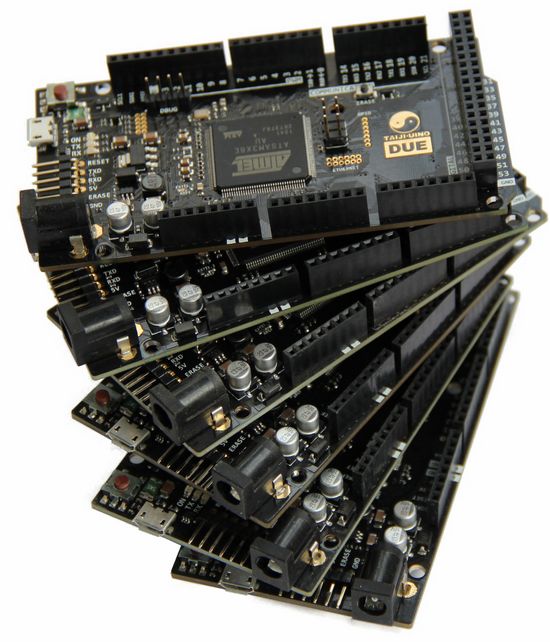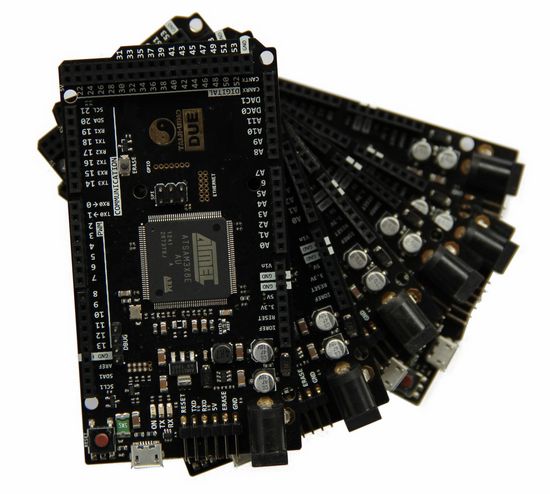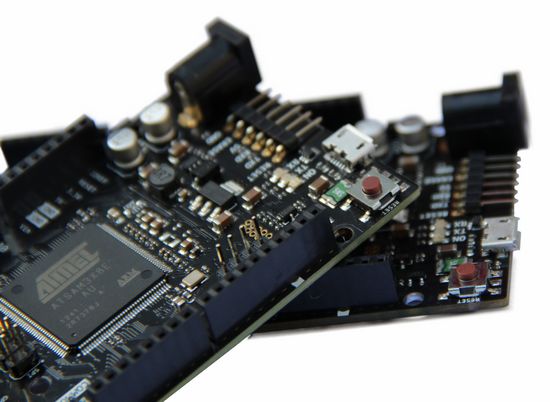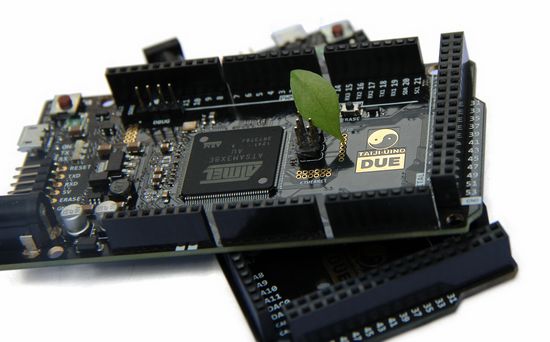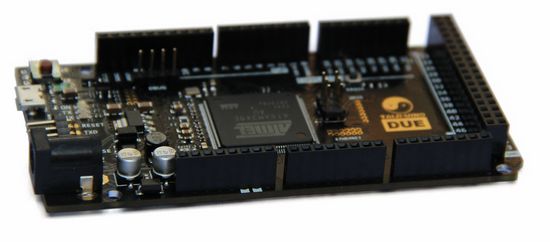
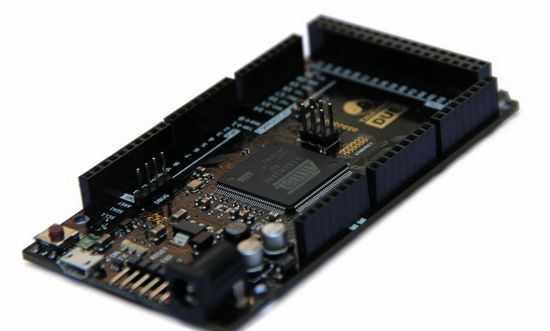


TAIJIUINO Due Pro board derives from Arduino Due. It is completely compatible with Arduino Due. Users could program it with Arduino IDE.
While we got the Arduino DUE board, our feeling is: oh, so complicated! We found it could be programmed either through Programming USB port or Native USB Port on Arduino Due. The we thought, why not remove one USB Port, to keep it simple and leave users more chances for innovation. As ATmega16U2 circuit takes much space on the board, we decide to remove it.
Extenal programmer is more cost-efficient. Similar with boards such as Arduino Mini or Arduino Pro, many boards could share one external programmer. If you need 10 boards to build your projects, you only need one external programmer. That will save you much money.
We developed 2 kinds of external programmer:
DUE_PROG
You could get this product from this page.
Basically this module is designed based on the ATmega16U2 circuit on Arduino DUE. With the bended-pin female header, users could plug in the header to Taijiuino Pro board.
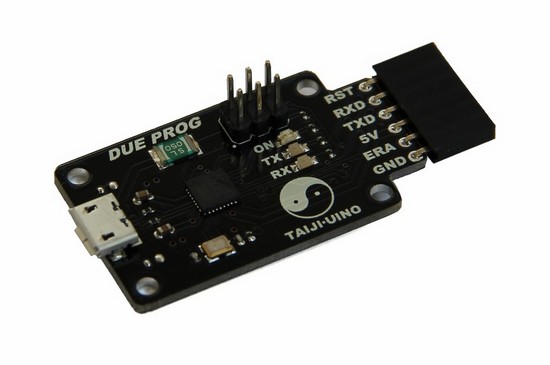
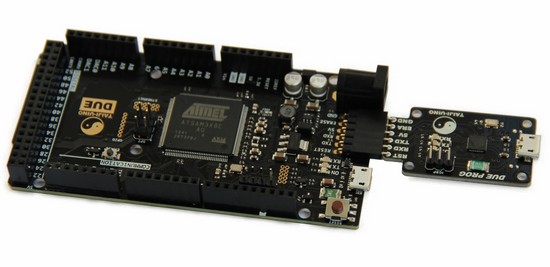
DUE WIRELESS PROG (In developing)
(Picture of beta board)
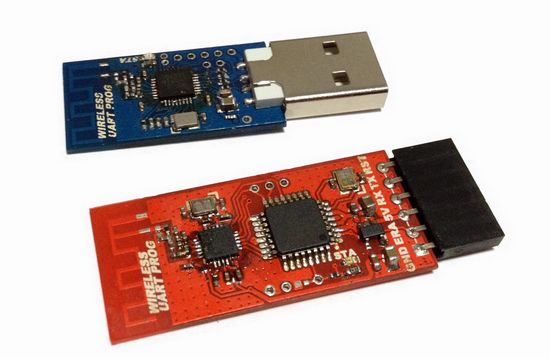
This module could program the Taijiuino board wirelessly. So far we almost finished the software and hardware work. We still need sometime to improve it before bringing it to market. We believe in some cases, wireless programming will offer great help.
This module could also be used to send data wireless between PC and TAIJIUINO board.
As we could see from the schematic of Arduino DUE, ATSAM3X8E has several pins which are not broken out on Arduino DUE. For most Arduino users, those pins will not be used anyway. However, we believe that on certain occasion they will be used.
We also found that the Arduino DUE schematic contains ethernet pins which, however, are not found on Arduino DUE board. It might because of the limited space on the Arduino Due board. We break them out on Taijiuino Pro Board.
Led on Pin 13 might be helpful sometimes. We found that both PC30 and PA23 connected with LEDs. Users could use those 2 leds if neccessary. So we remove the led on pin 13 to keep the board more simple.
Warning: same with Arduino Due, this board runs at 3.3V. The maximum voltage that the I/O pins can tolerate is 3.3V. Providing higher voltages, like 5V to an I/O pin may damage the board.
The TAIJIUINO Due Pro is a microcontroller board based on the Atmel SAM3X8E ARM Cortex-M3 CPU (datasheet).It has 54 digital input/output pins (of which 12 can be used as PWM outputs), 12 analog inputs, 4 UARTs (hardware serial ports), a 84 MHz clock, an USB OTG capable connection, 2 DAC (digital to analog), 2 TWI, a power jack, an SPI header, a JTAG header, a reset button and an erase button.
The board contains everything needed to support the microcontroller; simply connect it to a computer with a micro-USB cable or power it with a AC-to-DC adapter or battery to get started. This board is compatible with all Arduino shields that work at 3.3V and are compliant with the 1.0 Arduino pinout.
The Due follows the 1.0 pinout:
The Due has a 32-bit ARM core that can outperform typical 8-bit microcontroller boards. The most significant differences are:
EAGLE files: TAIJIUINO-Due-Pro-Reference-design.zip
Gerber files: TAIJIUINO-Due-Pro-gerber.zip
Schematic: TAIJIUINO-Due-Pro-schematic.pdf
| Microcontroller | AT91SAM3X8E |
| Operating Voltage | 3.3V |
| Input Voltage (recommended) | 7-12V |
| Input Voltage (limits) | 6-20V |
| Digital I/O Pins | 54 (of which 12 provide PWM output) |
| Analog Input Pins | 12 |
| Analog Outputs Pins | 2 (DAC) |
| Total DC Output Current on all I/O lines | 130 mA |
| DC Current for 3.3V Pin | 800 mA |
| DC Current for 5V Pin | 800 mA |
| Flash Memory | 512 KB all available for the user applications |
| SRAM | 96 KB (two banks: 64KB and 32KB) |
| Clock Speed | 84 MHz |
The TAIJIUINO Due Pro can be powered via the USB connector or with an external power supply. The power source is selected automatically.
External (non-USB) power can come either from an AC-to-DC adapter (wall-wart) or battery. The adapter can be connected by plugging a 2.1mm center-positive plug into the board's power jack. Leads from a battery can be inserted in the Gnd and Vin pin headers of the POWER connector.
The board can operate on an external supply of 6 to 24 volts. If supplied with less than 7V, however, the 5V pin may supply less than five volts and the board may be unstable. If using more than 12V, the voltage regulator may overheat and damage the board. The recommended range is 7 to 12 volts.
The power pins are as follows:
The SAM3X has 512 KB (2 blocks of 256 KB) of flash memory for storing code. The bootloader is preburned in factory from Atmel and is stored in a dedicated ROM memory. The available SRAM is 96 KB in two contiguous bank of 64 KB and 32 KB. All the available memory (Flash, RAM and ROM) can be accessed directly as a flat addressing space.
It is possible to erase the Flash memory of the SAM3X with the onboard erase button. This will remove the currently loaded sketch from the MCU. To erase, press and hold the Erase button for a few seconds while the board is powered.
The AREF pin is connected to the SAM3X analog reference pin through a resistor bridge. To use the AREF pin, resistorBR1 must be desoldered from the PCB.
Other pins on the board:
The Taijiuino Due Pro has a number of facilities for communicating with a computer, another Arduino or other microcontrollers, and different devices like phones, tablets, cameras and so on. The SAM3X provides one hardware UART and three hardware USARTs for TTL (3.3V) serial communication.
The Programming port is broken out for expternal programmers. Those pins could also be used to communicate with Taijiuino board. The TXD and RXD pins are connect to TX0 and RX0 pins of Taijiuino board through a TTL shifter, which converts TTL between 5V and 3V3.
The Native USB port is connected to the SAM3X. It allows for serial (CDC) communication over USB. This provides a serial connection to the Serial Monitor or other applications on your computer. It also enables the Due to emulate a USB mouse or keyboard to an attached computer. To use these features, see the Mouse and Keyboard library reference pages.
The Native USB port can also act as a USB host for connected peripherals such as mice, keyboards, and smartphones. To use these features, see the USBHost reference pages.
The SAM3X also supports TWI and SPI communication. The Arduino software includes a Wire library to simplify use of the TWI bus; see the documentation for details. For SPI communication, use the SPI library.
The TAIJIUINO Due Pro can be programmed with the Arduino software (download). For details, see the reference and tutorials.
Uploading sketches to the SAM3X is different than the AVR microcontrollers found in other Arduino boards because the flash memory needs to be erased before being re-programmed. Upload to the chip is managed by ROM on theSAM3X, which is run only when the chip's flash memory is empty.
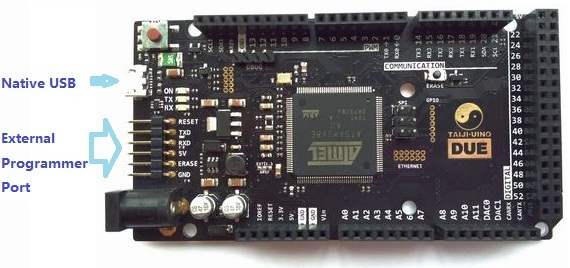
There are two ways to program the boards:
The TAIJIUINO Due Pro has a resettable polyfuse that protects your computer's USB ports from shorts and overcurrent. Although most computers provide their own internal protection, the fuse provides an extra layer of protection. If more than 500 mA is applied to the USB port, the fuse will automatically break the connection until the short or overload is removed.
